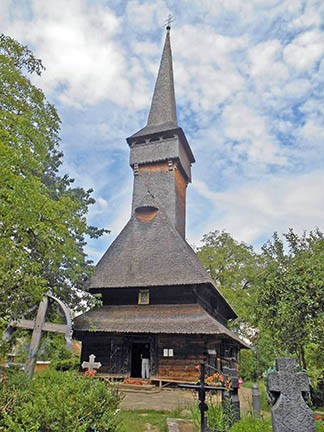Partner Church Congregation
The Szentegyhaza congregation is a triple minority in Romania. First, they are Unitarians in a country predominantly Romanian Orthodox. Second, they are Hungarian speakers where the majority of the country speaks Romanian. And third, they identify themselves as Szeklers, a minority subset of Hungarians living in Romania with many retired elders who provide the leadership and organizational tasks to help the minister, Rev. Szabolcs Kelemen. The younger members must find work away from the village and are  not available during the week. The congregation cares for those ill and needing special care. The church has their Sunday services streamed virtually for those who are unable to attend. The church is small and the congregation is large, so the members find ways to include everyone. They built a pavilion near the minister’s house for large gatherings, dances, dinners and parties.
not available during the week. The congregation cares for those ill and needing special care. The church has their Sunday services streamed virtually for those who are unable to attend. The church is small and the congregation is large, so the members find ways to include everyone. They built a pavilion near the minister’s house for large gatherings, dances, dinners and parties.
Sunday Service Activities
Every visit to our partner church usually ends with attending and participating in their Sunday church service before we leave. The church is in the understory of the minister’s home. At different visits the congregation has sat with women at one side and men on the other; other times they have been mixed. We usually sit together as we may have things to say or show after the service. The minister speaks not only in Hungarian but in English as well so all can understand. When members of our group speak, it is translated, also. At the end of the service, there is the exchanging of gifts. After this, we gather outdoors for a Transylvanian Style BBQ! Members of their congregation had been cooking goulash all morning.
Partner Church Gift Exchange
The Transylvanians are extremely generous people and the giving of gifts is deeply engrained in the culture, says the UU Partner Church Council Travel Guide Book for our pilgrimage. Exchanging of gifts between our two churches has been a thoughtful tradition allowing that gift to remind us of our friendship and the bond between us when we cannot be together. On our first trip we were presented their church banner and we gave them a Rhode Island flag. The Szentegyhaza congregation has talented members in wood working, embroidery, and fabric arts skills, and we have received many examples of their crafts. On the 2015 trip, we gave them a glass chalice made by a glass artist member of our church. Their Women’s Alliance and our Women’s Alliance also exchange gifts.
Out and About in the Village
The village of Szentegyhaza is in Hargita County, Romania, an area that is predominately Hungarian speaking. It is located near the Carpathian Mountains, at an elevation of 2,800 feet. There are several churches in the immediate area, but this is the only Unitarian Church. The Szentegyháza Unitarian Church has about 300 members.
The town is rural and does not have a lot of large businesses although it was home to a large steel factory, abandoned in the fall of communism. A number of the people in town farm for a living. Cows are lead along village streets to nearby pastures in the morning and are brought back in the evening. Due to a limited economy, a number of members of the congregation work in other countries during a part of the year and spend long periods of time far from home. Consequently, the full congregation does not usually attend services on Sunday. Rev. Kelemen has made use of streaming technology to maintain contact with them. However, church attendance is especially high during major holidays when the small church cannot accommodate everyone.
and are brought back in the evening. Due to a limited economy, a number of members of the congregation work in other countries during a part of the year and spend long periods of time far from home. Consequently, the full congregation does not usually attend services on Sunday. Rev. Kelemen has made use of streaming technology to maintain contact with them. However, church attendance is especially high during major holidays when the small church cannot accommodate everyone.
The congregation has been in existence for over 25 years and was formed a few years after the Romanian Revolution of 1989 that toppled the Communist regime.
- Of the many interesting places to visit in the village, one is the Cultural center that features the Szentegyhaza Philharmonic and the Children’s Choir, which is composed of children of the village and surrounding areas. These talented children have
 performed all over Europe.
performed all over Europe. - Another must-see is the Craft Museum that features examples of historic crafts with a collection of farm implements and household items over the last few centuries. The museum provides lessons in traditional woodworking, pottery, weaving, and other skills.
- A visit to the mineral spring is always encouraged to fill up your travel mug and sample the local water.
Other interesting sites nearby the village include:
- The Szekely battle site of Nyergesteto where a small band of Szekler men tried to hold off a much greater Russian force and were ultimately killed after being betrayed by a local shepherd.

- The 1000 Szekler Girls Festival where women and men in traditional clothes gather to celebrate their Szekely heritage.
- In the mountains where we also learned about the Swans of St. Anne’s Lake,
- Bözöd, home of the Sabatarians who were Christians who observed Jewish rituals and religious practices.
- Kőrispatak (Criseni) which is the home of a straw museum,
- Korond which is a local ceramic center.
- Homoródfürdő where we enjoyed its hot springs/spas,
- Visit historic monuments important to the area and the founding of Hungary.
